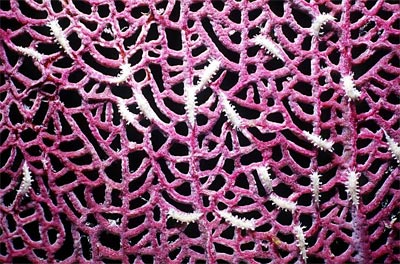
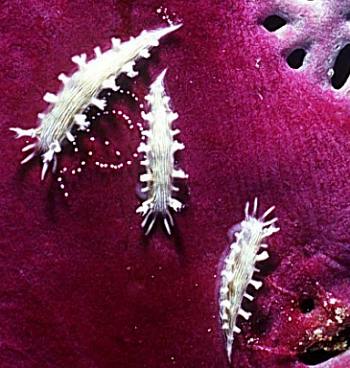
Tritonia hamnerorum
Gosliner & Ghiselin, 1987
Order: NUDIBRANCHIA
Suborder: DENDRONOTINA
Family: Tritoniidae
DISTRIBUTION
Caribbean
PHOTO
Little Cayman, British West Indies. Dive Site: Bloody Bay, July, 2001, Depth: 30 feet,
Size: 1/4 to 1/2 inch. Photos Anne DuPont.
This relatively small tritoniid feeds exclusively on gorgonian sea fans and is sometimes found in large numbers. Croniin et al (1995) report finding T. hamnerorum in Florida at extremely high densities, with as many as 1700 nudibranchs on a single colony of Gorgonia ventilina. T. hamnerorum removes distasteful chemicals from the sea fans and stores them for its own defence.
References:
• Cronin, G., Hay, M.E. Fenical, W., Lindquist, N. (1995) Distribution, Density, and Sequestration of Host Chemical Defenses by the Specialist Nudibranch Tritonia hamnerorum Found at High Densities on the Sea Fan Gorgonia ventalina. Marine Ecology Progress Series, 119(1-3): 177-189.
• Gosliner, T.M., Ghiselin, M.T. (1987). A new species of Tritonia (Opisthobranchia: Gastropoda) from the Caribbean Sea. Bull. Mar. Sci., 40(3): 428-436.
Rudman, W.B., 2002 (January 20) Tritonia hamnerorum Gosliner & Ghiselin, 1987 . [In] Sea Slug Forum. Australian Museum, Sydney. Available from http://www.seaslugforum.net/find/trithamn
Related messages
Tritonia hamnerorum from St. Vincent
September 15, 2007
From: Linda Ianniello


Dr. Bill,
Here are two images of what I believe are Tritonia hamnerorum, and one is laying eggs. When we find them in Southeast Florida, USA, they are generally on gorgonaian sea fans and are white. However we didn't notice any sea fans in St. Vincent, and found these on the "sea rod" type of gorgonians where they had more brown coloring, especially on the cerata, to match their host?
Locality: West Coast of St. Vincent Isalnd, 40 feet, West Indies, Caribbean Sea, 24 July 2007, Reef with sandy bottom. Length: approx. 1 inch. Photographer: Linda Ianniello.
Thank you VERY much for all the work you do on the forum. It is extremely informative and a great resource.
Regards,
Linda I.
lindai1@bellsouth.net
Ianniello, L.M., 2007 (Sep 15) Tritonia hamnerorum from St. Vincent. [Message in] Sea Slug Forum. Australian Museum, Sydney. Available from http://www.seaslugforum.net/find/20718
Dear Linda,
I wouldn't be at all surprised if the colour of the gills matches the colour of the gorgonian polyps, but that doesn't quite explain the bright reddish gills in the animals Stephane Ores has photographed in Martinique [see message #19577]. Your animals are a nice intermediate between the gills of the Martinique animals and the 'normal' whitish gills.
Thanks also for your supportive comments on the Forum. It would however be very dull and boring without the exciting and valuable contributions of all the contributors.
Best wishes,
Bill Rudman
Tritonia hamnerorum from West Indies
June 22, 2007
From: Jim Chambers
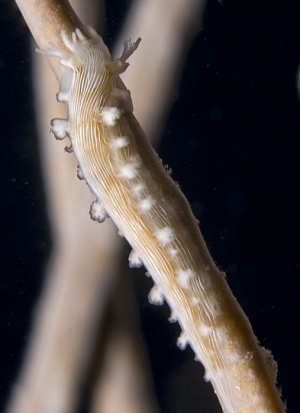
G'Day, Bill.
While diving on Little Cayman, British West Indies (Caribbean Sea) in May 2007, I saw what I think is a Tritonia hamnerorum on a gorgonian at a depth of about 10-12 meters. Not a very good photo, but recognizable. During the time we were on Little Cayman, we saw a number of these.
Cheers,
Jim Chambers
Georgia, USA
jimbo1946@mindspring.com
Chambers, J., 2007 (Jun 22) Tritonia hamnerorum from West Indies. [Message in] Sea Slug Forum. Australian Museum, Sydney. Available from http://www.seaslugforum.net/find/20036
Thanks Jim,
It would be interesting to know if you have ever seen one with the reddish pigmentation seen in Stephane Ores' photos [#19577]. From the photos on the Forum it seems as though this species feeds on a number of gorgonians - or else one gorgonian has a number of different life forms.
Best wishes,
Bill Rudman
Re: Tritonia hamnerorum from Martinique
April 20, 2007
From: Stephane Ores
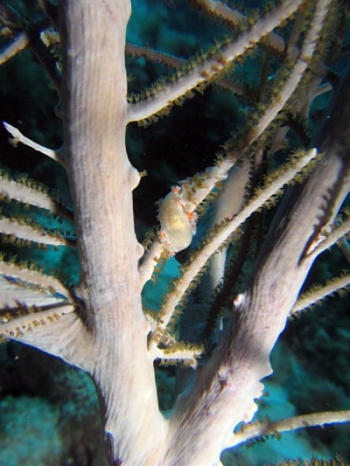
Concerning message #19673:
I have some more pictures on which the gorgonian could be seen in a better way if it could be helpful..
Locality: Diamant, Martinique (F.W.I.), Caribbean sea, 23 February 2007, Good visibility. Photographer: Stephane Ores.
Stephane Ores
stephane.ores@neuf.fr



Dear Stephane,
I have tried all my resources to identify your gorgonian, but none of the experts are able to even make a guess. Dr. Gary Williams of the California Academy of Sciences even suggested that this critter might even be a black coral and not a gorgonian, at all. My guess is Bill is correct on the identification of the tritoniid.
Sorry we couldn't be of more help.
Best wishes,
Dave Behrens
Re: Tritonia hamnerorum from Martinique
March 16, 2007
From: Kristen Whalen
Concerning message #19577:
Hi Bill and Stephane,
I have collected Tritonia hamnerorum from reefs around the Exuma Keys in the Bahamas. In all my collections, I have never come across any specimens with this red-orange coloration. I have examined well over 600 individuals. I haven't by any means done an exhaustive search throughout the Caribbean. Do you remember what the gorgonian looked like? T. hamnerorum has only been reported to feed on gorgonians in the genus Gorgonia. Quite interesting coloration. Reminds me of fire worms that frequent gorgonians as well.
I am looking at the gorgonian in the photograph, it is hard to tell what species it is, but it doesn't look like Gorgonia sp., it looks more like a sea plume, perhaps a Pseudopterogoria sp. perhaps.
Kristen
kwhalen@whoi.edu
Whalen, K., 2007 (Mar 16) Re: Tritonia hamnerorum from Martinique. [Message in] Sea Slug Forum. Australian Museum, Sydney. Available from http://www.seaslugforum.net/find/19673Dear Kristen,
How is your PhD work going?[#15933]. I agree that identifying this animal with T. hamnerorum may be a bit far-fetched. Everyone who has reported it talks of hundreds, or even thousands of specimens, and none have mentioned red markings like in Stephane's single specimen. But its shape and black lines are identical, so it seems worth looking at the possibility that it is a colour form. Of course what we really need is more specimens and someone to compare their anatomy.
Best wishes,
Bill Rudman
Tritonia hamnerorum from Martinique
March 7, 2007
From: Stephane Ores

Hello Bill,
I found this beautiful nudibranch on a gorgonian, but I couldn't identify it..
Locality: Diamant, 15 m, Martinique (French West Indies), Caribbean Sea, 23 February 2007. Length: 20 mm. Photographer: Stephane Ores.
Thank you for help
Best regards
Stephane
stephane.ores@neuf.fr
Ores, Stephane, 2007 (Mar 7) Tritonia hamnerorum from Martinique. [Message in] Sea Slug Forum. Australian Museum, Sydney. Available from http://www.seaslugforum.net/find/19577
Dear Stephane,
I am pretty sure this is the gorgonian-feeding Tritonia hamnerorum. The only difference I can see externally is the presence of orange-red on the rhinophore sheaths, the gill stalks, and as a faint band on the tentacles on the oral veil. Other aspects of the colour are identical, as is the relative size of the gills, shape of the body, and number of tentacles on the oral veil.
I would be interested in comments from anyone familiar with T. hamnerorum or this red marked 'form' or 'species'.
Best wishes,
Bill Rudman
Update on Tritonia hamnerorum in Bermuda
August 1, 2006
From: Thad Murdoch
Concerning message #14469:
T. hamnerorum has reappeared on Bermuda rim reefs for the second year. Observed on snorkel at three sites. The re-emergence of the nudibranch was unexpected, since none was seen over the winter. Will carry out cross-platform assessment again this year.
Locality: Ledge Flats, North Lagoon, 3 m, Bermuda, Atlantic Ocean, 27 July 2006, Shallow rim reef. Length: 13 mm
Thad Murdoch
tjmurdoch@gov.bm
Murdoch, T.J.T., 2006 (Aug 1) Update on Tritonia hamnerorum in Bermuda. [Message in] Sea Slug Forum. Australian Museum, Sydney. Available from http://www.seaslugforum.net/find/17269Dear Thad,
Thanks for keeping us informed. It would be very interesting to know something of their larval development.
Best wishes,
Bill Rudman
Re: Tritonia hamnerorum in Bermuda
February 24, 2006
From: Kristen Whalen
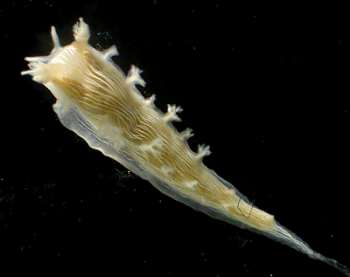
Concerning message #14424:
In January 2003 and January 2006 I found 4-100 individuals of Tritonia hamnerorum per sea fan in shallow reefs off of Lee Stocking Island, Bahamas. It is not uncommon for this organism to kill its host. This is exactly what I look for when I am trying to find this cryptic nudibranch. I scan for dead patches or dying Gorgonia ventalina (purple sea fan) and I am sure to find the nudibranch. I have found individuals ranging in size from 1.5cm - 3 mm. I tend to find the larger individuals only in small groups of less than 50. While the small individuals can range in abundance from 100-1000 per sea fan.
A portion of my Ph.D. thesis concerns the biochemical mechanism these nudibranchs use to concentrate and detoxify gorgonian chemical defenses.
Locality: Woods Hole Oceanographic Inst., 5-35 feet, Mass., Caribbean, January 2006, On sea fans. Length: 1.5 cm (largest). Photographer: Kristen Whalen.
Kristen Whalen
kwhalen@whoi.edu
Whalen, K., 2006 (Feb 24) Re: Tritonia hamnerorum in Bermuda. [Message in] Sea Slug Forum. Australian Museum, Sydney. Available from http://www.seaslugforum.net/find/15933Dear Kristen,
Thanks for keeping us informed of your work. I look forward to any updates in the future
Best wishes,
Bill Rudman
Found this guy on Roatan, Honduras
January 11, 2006
From: Brian Ricker

We found this guy on the wreck of the Prince Albert off the coast of Roatan Honduras:
Locality: Wreck of the Prince Albert, Roatan, Honduras, Gulf of Mexico. Depth: 60 ft. Length: ~ 4 inches. 15 Oct 2005. Photographer: Brian Ricker
Brian Ricker
bricker@nc.rr.com
Ricker, B.S., 2006 (Jan 11) Found this guy on Roatan, Honduras. [Message in] Sea Slug Forum. Australian Museum, Sydney. Available from http://www.seaslugforum.net/find/15518
Dear Brian,
I am pretty sure this is Tritonia hamnerorum. Like most tritoniids, it is well camouflaged on its soft-coral food. My only doubt about its identity is your size estimate of approx 4 inches. As far as I know T. hamnerorum has only been reported to grow to about 1 inch [25 mm] in length.
Best wishes,
Bill Rudman
Re: Tritonia hamnerorum in Bermuda
August 3, 2005
From: Thaddeus Murdoch
Have since carried out an assessment of the extent of the outbreak [see message #14424 ]. The western extent was tentatively found, and the northern, eastern and southern edges not reached yet. At least 20 sq. km of patch and fore-reef are being affected to a depth of at least 30 ft. Several popular dive sites within MPAs are heavily affected as well.
Locality: Patch and Fore Reef, Bermuda. Atlantic Ocean. Depth: 3-30 ft. Length: 25 mm max. 01 August 2005. Patch and Rim reefs.
Thad Murdoch
tjmurdoch@gov.bm
Murdoch, T.J.T., 2005 (Aug 3) Re: Tritonia hamnerorum in Bermuda. [Message in] Sea Slug Forum. Australian Museum, Sydney. Available from http://www.seaslugforum.net/find/14469Dear Thad,
Thanks for keeping us up to date
Best wishes,
Bill Rudman
Tritonia hamnerorum in Bermuda
August 1, 2005
From: Thad Murdoch


On July 14th our research team found an outbreak population of hundreds of Tritonia hamnerorum on a small patch reef in the lagoon in Bermuda. Neighbouring patch reefs were also affected but so far it appears the outbreak is localized, as sites over 10 km away were free of nudibranchs. Specimens were collected for microscopic photography and also were stored in the Bermuda Natural History Museum.
Roughly 50% of all sea fans on the patch were already dead and about 1/2 remaining were infested with the nudibranch.
Photo B: Heavily grazed sea fan coasted in tuft algae in Bermuda
Photo C: Juvenile Tritonia hamnerorum aprox 3mm long on sea fan
Locality: Devil's Flats, Bermuda, Atlantic Ocean. Depth: 2 m. Length: 5 - 15 mm. 14th July 2005, 20th July 2005. On sea fans only, on a 10-m long patch reef within a large expanse of patch reefs within the lagoon
Photographer: Thad Murdoch, James Woods
Thad Murdoch
[Bermuda Reef Ecosystem Assessment and Mapping (BREAM) Project.
Bermuda Biodiversity Programme. Bermuda Zoological Society and Bermuda Government Dept. of Conservation Services]
tjmurdoch@gov.bm
Murdoch, T.J.T., 2005 (Aug 1) Tritonia hamnerorum in Bermuda. [Message in] Sea Slug Forum. Australian Museum, Sydney. Available from http://www.seaslugforum.net/find/14424
Dear Thad,
Thanks for this interesting observation. This is quite a usual behaviour for many nudibranchs. Distribution s very patchy, often occurring as a very localised, concentrated infestation. It seems as though they arrive as a larval swarm, which settles out of the plankton on to their food organism, where they live, breed and die. In most cases it is the prey organism that triggers the larvae to settle out of the plankton and metamorphose. It's bad luck for the prey colonies, but fortunately the overall nudibranch population is relatively small so the overall prey population is more than capable of withstanding the effects of nudibranch predation.
Best wishes,
Bill Rudman
Tritonia hamnerorum from Florida, USA
June 12, 2003
From: Paul Osmond


Last weekend [June 2003] we found over 50 animals of Tritonia hamnerorum on several sea fans on a reef in Islamorada, Florida - just south of Key Largo.
Several Sea Fans on the site showed evidence of heavy damage from either these nudibranchs or Flamingo Tongues which were also seen in the area.
Every other sea fan had several specimans on, although not the numbers reported by others - maximum of 8 on a single fan.
Paul Osmond
Deep Sea Images
www.deepseaimages.com
deepsea@deepseaimages.com
Osmond, P., 2003 (Jun 12) Tritonia hamnerorum from Florida, USA. [Message in] Sea Slug Forum. Australian Museum, Sydney. Available from http://www.seaslugforum.net/find/10155Thanks Paul,
Bill Rudman
Tritonia hamnerorum from the West Indies
January 21, 2002
From: Anne DuPont


Hi Bill,
I first photographed Tritonia hamnerorum in the Florida Keys about 15 years ago. When I started getting serious I researched it and found a paper by Dr. Greg Cornin regarding a population outbreak of Tritonia hamnerorum in the Keys a few years later. http://carbon.cudenver.edu/~gcronin/tritonia.htm
Mike Miller put one of the Keys photos up as a BOW. http://siolibrary.ucsd.edu/slugsite/nudwk190.htm
In July last year while diving in the Cayman Islands, I found one large sea fan covered with Tritonia hamnerorum. This was the only one in a week of diving.
Date: July, 2001
Depth: 30 feet
Size: 1/4 to 1/2 inch
Photo taken: Little Cayman, British West Indies
Dive Site: Bloody Bay
Cordially,
Anne
akdupont@bellsouth.net
DuPont, A., 2002 (Jan 21) Tritonia hamnerorum from the West Indies. [Message in] Sea Slug Forum. Australian Museum, Sydney. Available from http://www.seaslugforum.net/find/5937Thanks Anne,
Bill Rudman
